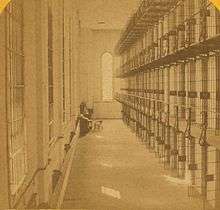Detroit House of Correction
| Location | Plymouth Township, Michigan |
|---|---|
| Status | Closed |
| Opened | 1861 |
| Closed | December 2004 |
| Managed by | Michigan Department of Corrections |
The Detroit House of Correction (DeHoCo), opened in 1861, was owned and run by the city of Detroit but originally accepted prisoners from throughout the state including women. The Detroit House of Correction was transferred to the state in 1986, renamed to Western Wayne Correctional Facility, and became a women's facility for the rest of its tenure. It closed in December 2004 and all inmates and staff were transferred to the Women's Huron Valley Correctional Facility in Ypsilanti.
History
_Detroit%2C_p269_DETROIT_HOUSE_OF_CORRECTION.jpg)

The first Detroit House of Correction opened in 1861 near Detroit's Eastern Market.[1]
In 1919, the city of Detroit purchased approximately 1,000 acres (400 ha) in Plymouth Township and Northville Township for approximately US$30 (equivalent to $410.15 in 2015) an acre to house a new Detroit House of Correction. A prison camp, with inmates sleeping in tents, was opened in 1920. A permanent US$2,500,000 (equivalent to $35,473,108 in 2015) maximum security facility was completed in 1930.[1][2]
The city of Detroit sold a portion of the complex to the Michigan Department of Corrections in 1979 for US$1,600,000 (equivalent to $5,225,493 in 2015), and the remainder of the facility to the department in 1986 for US$6,700,000 (equivalent to $14,488,191 in 2015). The facility was then renamed to Western Wayne Correctional Facility and became a women's facility for the rest of its tenure.[1] The 1930 building closed and has sat abandoned since.[2]
The facility closed in December 2004 and all inmates and staff were transferred to the Women's Huron Valley Correctional Facility in Ypsilanti.
In January 2002, Kojaian Management Corporation purchased the property for US$50,000,000 (equivalent to $65,892,692 in 2015).[1]
Detroit ownership
Plymouth Township acquired 323 acres (131 ha) of the property in September 2011 for US$606,150 (equivalent to $638,699 in 2015). The land was available for purchase by the government due to unpaid taxes.[3][4]
In May 2016, the City of Detroit, is in ownership of 190 acres of the land Plymouth Township acquired. The courts agreed that under Michigan land law, the ownership of the property still resides with the City of Detroit. The other 133 acres, of the 323 Plymouth Township acquired, was correctly sold, by Detroit, in 2006, to a private developer, who did not pay their land taxes, and forfeited the land to the township. Just to the east of this property, the City of Detroit, owns 45 acres of the original site, where dilapidated prison structures still stood as of May 2016.[5]
Notable inmates
Notable inmates during the prison's history included:
See also
References
- 1 2 3 4 5 6 Petlewski, Kathy. "Detroit House of Correction - History". plymouthlibrary.org. Plymouth District Library. Retrieved 2015-07-27.
- 1 2 Tippen, Molly (November 10, 2010). "No Business Prospects for Long-Abandoned Detroit House of Correction". Plymouth-Canton, Michigan Patch. Retrieved 2015-07-27.
- ↑ "Detroit disputes what it calls illegal sale of old jail site to Plymouth Township". Detroit Free Press. September 26, 2012. Retrieved 2015-07-27.
- ↑ Lawrence, Eric D. (May 30, 2014). "Detroit's claim on old prison stalls major suburban development plans". Detroit Free Press. Retrieved 2015-07-27.
- ↑ The Detroit Free Press, Detroit’s land fight with Plymouth Twp. ends after 3 years, by Matt Jachman, 9 May 2016, page 4A
- ↑ "Clipping from The Galveston Daily News on Newspapers.com". The Galveston Daily News. Associated Press. April 26, 1984. p. 14. Retrieved 2015-07-27 – via Newspapers.com.

- ↑ Jenkins, Kevin R. (July 21, 2015). "'Belle Starr' closes out Big River Chautauqua". Daily Journal Online. Retrieved 2015-07-27.